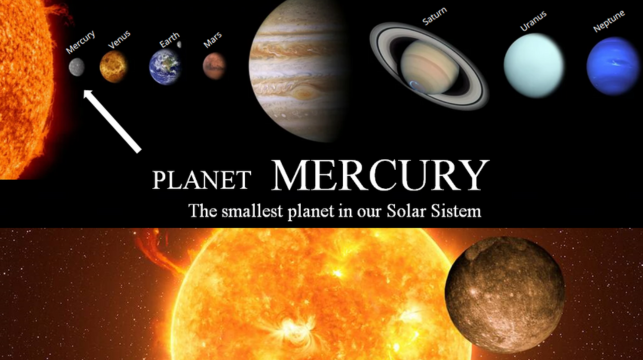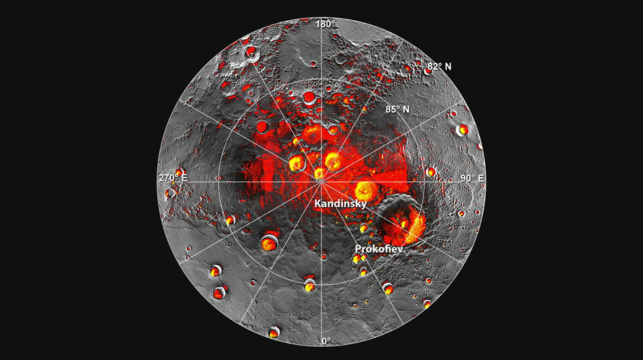1. In the Solar System, Mercury is the innermost planet which nearest to the sun.

Mercury is the deepest planet in our sun–oriented framework, circling the Sun at a normal distance of around 36 million miles (58 million kilometers). It is found between the Sun and Venus, making it the closest planet to the Sun. It’s orbit is highly elliptical, meaning its distance from the Sun shifts all through its circle. In spite of its nearness to the Sun, it isn’t the hottest planet within the Sun–based framework; that refinement goes to Venus due to its thick air and greenhouse effect impact.
2. Mercury is the smallest planet in the entire solar system.

Mercury, among the different celestial bodies in our sun-based framework, captures consideration as the foremost charming due to its minute measure. With an essential span of as it were 2,440 kilometers, it holds the qualification of being the littlest planet in our sun-based framework.
3. Mercury has nearly no environment to hold warm, its surface encounters a few of the biggest temperature swings within the sun-powered framework, with varieties of a few hundred degrees between day and night.

Mercury encompasses an exceptionally lean and shaky environment, regularly referred to as an exosphere. Not at all like the thick climates of Earth and Venus, it’s climate is composed of as it were trace sums of gases, fundamentally hydrogen, helium, oxygen, sodium, calcium, potassium, and water vapor.
The exosphere of this planet is greatly inadequate, with an add up to air weight of less than one-trillionth that of Earth’s air at ocean level. It is so lean that a person’s particles and atoms can travel hundreds of kilometers before colliding with another molecule. In general, it’s atmosphere is about non-existent compared to other planets within the solar system, contributing to its extraordinary temperature varieties and desolate surface conditions.
4. The planet Mercury is named after the Roman messenger god Mercury, who was known for his speed and agility and also equivalent to the Greek god Hermes.

In Roman mythology, Mercury was considered the god of exchange, commerce, monetary gain, messages, communication, and travelers, among other things. The planet Mercury, being the closest to the Sun and having a moderately quick orbital period, moves quickly over the sky from the viewpoint of Earth. This fast development likely contributed to the affiliation of the planet with the speedy messenger god.
The title “Mercury” was received for the planet in English and other dialects affected by Roman mythology. Additionally, other planets in our sun-based framework are also named after Roman or Greek divine beings and goddesses, reflecting antiquated social impacts on space science and celestial classification.
5. Caloris Basin is a huge impact basin on the surface of Mercury, generally 1,550 kilometers (960 miles) in breadth, making it one of the biggest impact basins within the solar system.

The Caloris Basin is one of the foremost noticeable highlights on its surface. The title “Caloris” comes from the Latin word for “heat,” reflecting the intense warmth experienced within the region due to its nearness to the Sun.
The Caloris Basin was shaped during the early history of the solar system, likely around 3.9 to 4.6 billion a long time ago, by the effect of an expansive asteroid or comet. The effect would have discharged a gigantic sum of energy, exhuming an endless cavity and causing the encompassing landscape to experience critical deformation. One of the particular highlights of the Caloris Basin is its complex framework of concentric rings of mountains and edges, which were shaped by the shock waves created by the effect. These rings can be a few kilometers tall and expand hundreds of kilometers from the center of the basin.
6. Mercury has the longest day and the shortest year of all the planets in our solar system.

Mercury rotates exceptionally slowly on its axis compared to its orbital period. It takes roughly 59 Earth days for this planet to total one turn on its axis. As a result, a single day on this planet (from one sunrise to the following) is proportionate to around 176 Earth days. This makes it the longest day of any planet within the solar system relative to its year.
Mercury’s circle around the Sun is the most limited of all the planets. It takes roughly 88 Earth days for this planet to total one circle around the Sun. This implies that a year on Mercury, the time it takes for the planet to total one revolution around the Sun, is as it were almost 88 Earth days.
7. Evidences shows that Mercury had volcanoes in the past.

Prove proposes that Mercury has experienced volcanic action within the past, in spite of the fact that it may not be as of now dynamic. The planet’s surface highlights smooth plains accepted to be the result of old volcanic streams. These volcanic fields propose that volcanic movement happened on its surface in its prior history.
Also, volcanic vents and highlights such as magma channels and pyroclastic deposits have been recognized on its surface, showing past volcanic eruptions. Be that as it may, there’s no proof to recommend that these volcanoes are as of now dynamic.
8. Mercury does not have any moons or rings.

Mercury does not have any moons or rings. It is one of the two planets in our solar framework that don’t have moons, the other being Venus. The non-appearance of moons and rings around It may be credited to different variables, counting its nearness to the Sun, its moderately little estimate, and its weak gravitational impact compared to bigger planets like Earth or Jupiter.
9. There’s proof to suggest that there may be ice on Mercury’s surface, especially in regions close to its poles.

In spite of being the closest planet to the Sun, Mercury’s axial tilt is nearly opposite to its circle, meaning that there are ranges close to the poles that are forever shadowed by the Sun’s direct beams. In these forever shadowed cavities, temperatures can drop low enough to back the presence of water ice.
Perceptions from NASA’s MESSENGER (MErcury, Surface, Space, ENvironment, GEochemistry, and Ranging) shuttle, which circled the planet from 2011 to 2015, identified radar-bright highlights in a few of these forever-shadowed regions. Radar-bright highlights are characteristic of substances with tall radar reflectivity, such as water ice. Also, MESSENGER’s instruments recognized hydrogen concentrations as reliable with the presence of water ice in these regions.
Besides, the European Space Agency’s BepiColombo mission, which arrived at Mercury in 2021, is anticipated to supply further bits of knowledge about the presence of water ice on its surface utilizing its suite of scientific instruments.
10. Mariner 10, launched by NASA, was the primary spacecraft to visit Mercury.

Mariner 10(1974-1975), launched by NASA, was the primary shuttle to visit Mercury. It made three flybys of the planet in 1974 and 1975, capturing the primary close-up pictures of Mercury’s surface and gathering critical information regarding its environment, magnetic field, and geography.
MESSENGER(2004-2015) stands for MErcury Surface, Space ENvironment, GEochemistry, and Ranging was a NASA shuttle that circled Mercury from 2011 to 2015. It gives broad information about Mercury’s surface, insides, magnetic field, and exosphere, enormously extending our understanding of the planet. It moreover affirmed the presence of water ice and organic compounds on Mercury’s surface.
At that point, there’s a joint mission between the European Space Agency (ESA) and the Japan Aerospace Exploration Agency (JAXA). Impelled in 2018, BepiColombo comprises two shuttles:
the Mercury Planetary Orbiter (MPO) and the Mercury Magnetospheric Orbiter (MMO). The mission points to consider Mercury’s surface, insides, exosphere, and magnetosphere in exceptional detail. BepiColombo arrived at Mercury in December 2025 and is right now conducting scientific observations.
There are so many informations like these, if you want to explore then click here